Fall Leaves Photography
Last Updated on June 24, 2025

Capture the beauty of autumn with stunning fall leaves photography. Learn how to shoot vibrant autumn colors and enhance your images with creative post-processing tips.
We don't love autumn as much as we love summer and spring. There are several reasons for this — lots of rain, fog, cold weather, colors fade, and no longer touch our souls. Nature is not rampant and is preparing for winter sleep, and in a short time, we can catch the yellow, orange, and crimson tones of autumn.
Fall leaves photography introduces people to the real and vibrant autumn nature for those who are too busy to go to the park or forest and see it with their own eyes. In this article, we will touch on how to take special autumn photos and how to apply post-processing to the resulting images in real life.
The Magic of Fall Leaf Photography
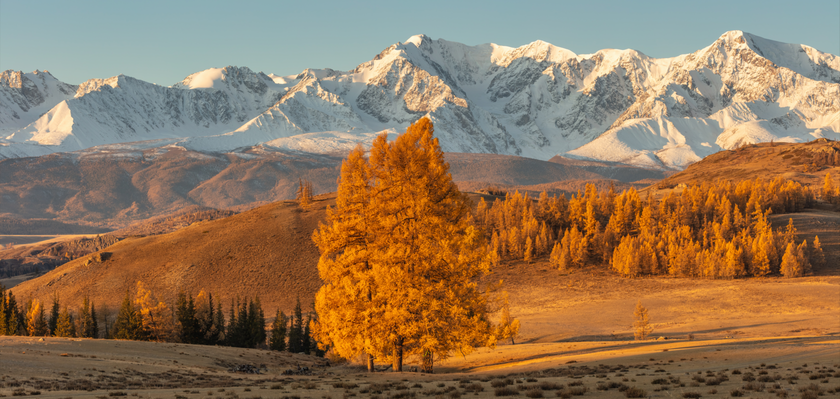
In summer, trees and grass are lush green. Autumn changes nature gradually, like a cat on soft paws. First come yellow spots, then orange, crimson, and dark brown. The colors overlap and shift daily. Fall leaf photography helps capture these changes.
To preserve that depth of color, you may need to lighten shadows or remove a gray cast added by the camera. Specialized software helps with this. If you're unsure where to start, check out the comparison between Luminar Neo and Lightroom. One offers quick, ready-made tools, the other — more control.
How to Plan a Trip to Photograph Fall Leaves

You need to think in advance about where to go and when to shoot to get good pictures. To do this, you can use reports on color changes or visit Facebook groups to exchange information about current conditions in the desired area.
Finding the Best Places to Photograph Fall Leaves
The location of the photo shoot affects the result. The more trees and less city noise, the easier it is to focus on color and shape. Autumn scenes look best where there's depth, water, and space.
Top locations:
an alley with maple or birch trees in a residential area;
a park path with curves and small elevation changes;
an old estate or cottage — contrasting nature and architecture.
Fall leaves photography works best in quiet places where you can pause, observe, and wait for the right light.
When to Shoot the Peak of Color
It's hard to predict exactly when autumn colors peak — leaves change at different times by region, and weather varies each year. Some years they turn yellow early, others later. If images look pale, it’s not a problem — they can be edited. In AI Enhance Images, just a couple of clicks can deepen colors and add light without overprocessing.
Elevate Your Photography with Our Advanced Software
Discover PricingConsider the Weather
The same day can bring very different lighting. If the sky ruins the shot or looks too gloomy, use Sky Replacement. But cloudy skies make leaf colors soft and calm — perfect for close-ups: drops on leaves, wet bark, reflections.
After rain, colors become deeper. Fog softly blurs the background in forests or open spaces. In sunny weather, light is warm and contrasty, with shadows and graphic structure.
Mastering Light and Composition
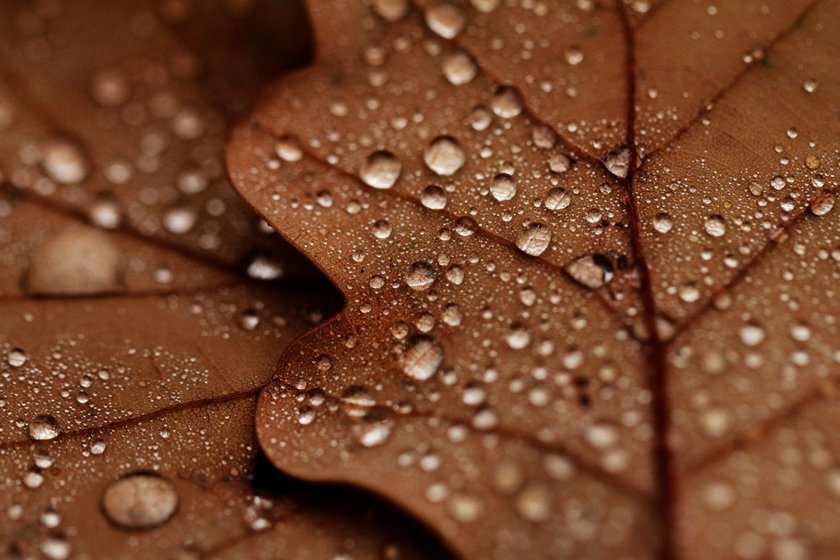
In autumn, the scene is already set — all the photographer has to do is notice where the light is coming from, how the lines are laid out, and where the shapes begin. Everything in the frame is already a finished story with a ready-made background.
Golden Hours Versus Cloudy Days
In the morning, we can use soft, golden light. It's good to photograph tree crowns against the light. The leaves begin to glow as if there were a light bulb inside them. Approach the tree from the east side and photograph the crowns from the bottom up when the sun has risen.
During the day, clouds act as a diffuser, so colors become even and sharp shadows disappear. Use fallen leaves from a close distance for your autumn photo shoot — without sharp shadows, texture and color spots are easier to see.
How to Use Light Direction For Vivid Photos
When you can see the direction of the light, you can control the mood of the photo. If the sun is behind you, you will get a silhouette. If it is to the side, the leaves will show volume. And if you shine light on them from the front, bright, saturated colors will appear. This is noticeable in fall leaf photography — the same leaf can look different if you simply step to the side. Hold the leaf between yourself and the sun, raise it slightly above your head, and the illuminated veins will become the center of the frame.
Use Natural Layers and Leading Lines in Your Composition
Layers create depth and guide the eye from foreground to background — leaves underfoot, a tree or person in the middle, fog or light in the distance. Shooting from a low angle shows how these layers overlap.
Leading lines — a road, fence, or shadows — subtly draw the eye into the frame. In fall leaves photography, they make the image «come alive». To enhance perspective and separate the planes, use the Best Photo Editor Program — its tools highlight details without looking artificial.
Don't Forget to Look Up
In autumn, tree crowns become real stained-glass windows. Just look up, and you will see patterns, light between the leaves, and cobwebs on the branches. This is one of the easiest ways to find a shot where you least expect it. It looks beautiful when the leaves shine through against a blue or gray sky.
Experiment With the Textures and Patterns of Fall Leaves
Leaves can be smooth, dry, spotted, or veined. They lie on the ground in layers, overlapping each other. If you look closely, you can see patterns, like in a carpet. This technique works well for details, macrophotography, or portrait backgrounds. The color, shape, and texture make the photo interesting even without additional objects. To process such frames without losing their naturalness, you can use Image Editing Software with soft settings.
Technical Tips For Photographing Fall Foliage
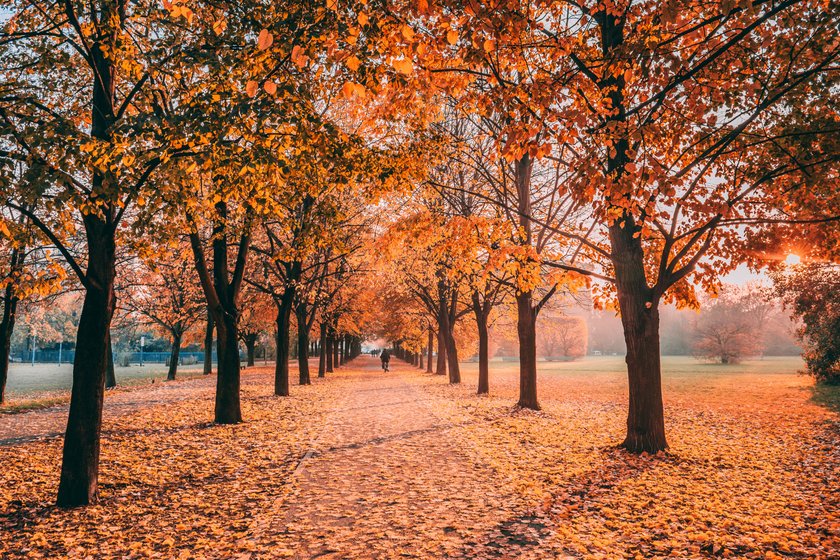
In autumn, there's less light, quick contrast shifts, and muted colors. A tripod helps with long exposures, and a polarizing filter enhances colors and removes glare, near water or after rain.
Try using these techniques in your work:
Tips | How it works in practice |
Use a polarizing filter | It removes glare and enhances colors on leaves and in reflections. This is especially noticeable after rain. |
Experiment with long exposure | Leaves blowing in the wind or water in the frame create a soft motion. Shoot with a tripod at 0.5 sec. |
Try camera movement (ICM) | When shooting, move the camera up or sideways. This creates a blurred texture similar to a painting. |
Check focus and sharpness | Enlarge the frame after shooting and look at the details. This is especially important when shooting in cloudy weather. |
These techniques are easy to adapt to any situation — in a park, at a cottage, in the forest, or in the yard. With their help, you can turn a simple shot into something you'll want to print out and hang on your wall.
Creative Ideas For Photographing Fall Leaves
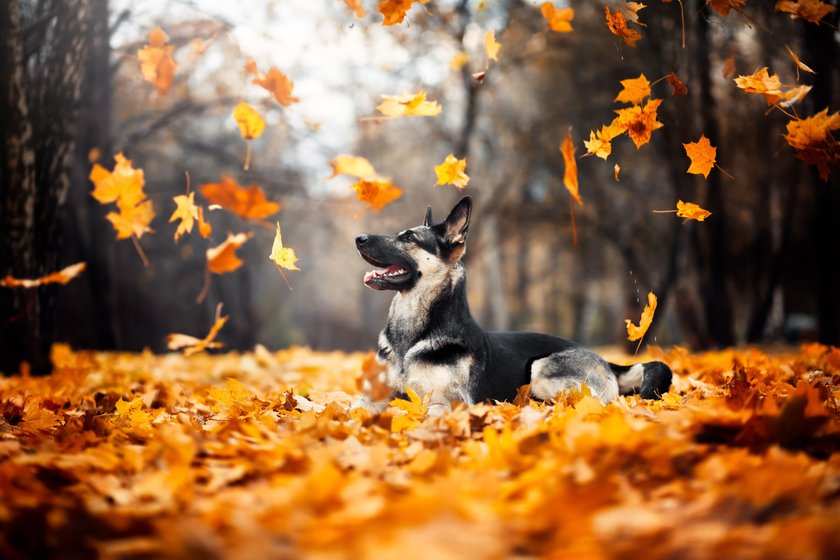
Autumn is by no means summer, yet it also has its abundance of simple and expressive scenes. Then just shift your shooting angle or get closer to the centre of the frame.
1. Capture Reflections in Water For a Double Effect
The reflections of autumn puddles, ponds, and lakes are like mirrors in which you can capture trees, the sky, the sun, and people's faces. This gives a sense of volume. Lean over the water and see how the branches of the trees connect with their reflections. You can achieve symmetry or create a slightly distorted frame. These techniques are often used in fall leaf photography to add depth to a simple landscape.
2. Focus on Small Scenes to Achieve a Big Effect
Not every shot needs a full forest. A single leaf, branch, or ground texture can say more, like a yellow leaf on dark soil or dew on the edge. Shoot at ground level to blur the background. Use AI Background Remover to clean up distractions.
Macrophotography shows veins, drops, and time traces on one leaf, like an abstract drawing. Move closer, focus manually, and shoot in cloudy weather to avoid glare. Such shots often appear in fall leaves photography collections for revealing hidden details.
3. Photograph People and Pets to Create a Story
When there is movement, gesture, or gaze in the frame, it comes to life and tells a story. Autumn works well as a backdrop, while people, children, and animals give the photos emotion and meaning. Ask them to simply walk along the path in bright clothing without posing. In fall leaves photography, the story is built around the moment—a step, the wind, the light in their hair.
Editing Fall Leaf Photos With Luminar Neo
 A camera cannot always accurately capture the natural autumn palette. Processing the resulting images helps to display what the photographer saw. In Luminar Neo, we recommend trying the following tools:
A camera cannot always accurately capture the natural autumn palette. Processing the resulting images helps to display what the photographer saw. In Luminar Neo, we recommend trying the following tools:
Balance warmth and contrast. Increase warmth to emphasize the softness of the scene. Then add contrast and highlight the layers. If the photo is too «noisy», Denoise Image will help fix photos taken in low light.
Presets for consistent aesthetics. With their help, you can even out the color, light, and shadows in one tone. If there is a gray sky in the frame, it is easy to replace it with the Sky Replacement tool so that the sky blends in with the overall picture.
Moderate color enhancement. Use it carefully. It is better to enhance individual shades than the entire frame at once. Picture Brightener helps to «pull» details out of the shadows without making the image flat. This is especially useful in fall leaf photography, where the play of light and color is the basis of the frame.
Post-processing helps make the frame «come alive» by boosting warmth and contrast. In cloudy weather, use Denoise Image to remove grain. If the photo looks flat, highlight red or orange tones and lighten shadows — the result will feel fresh and engaging.
Exclusive Tools of Endless Possibilities in One AI Editor
Explore Now!Photographing Fall Leaves Lies in Changing Your Attitude Toward Fall
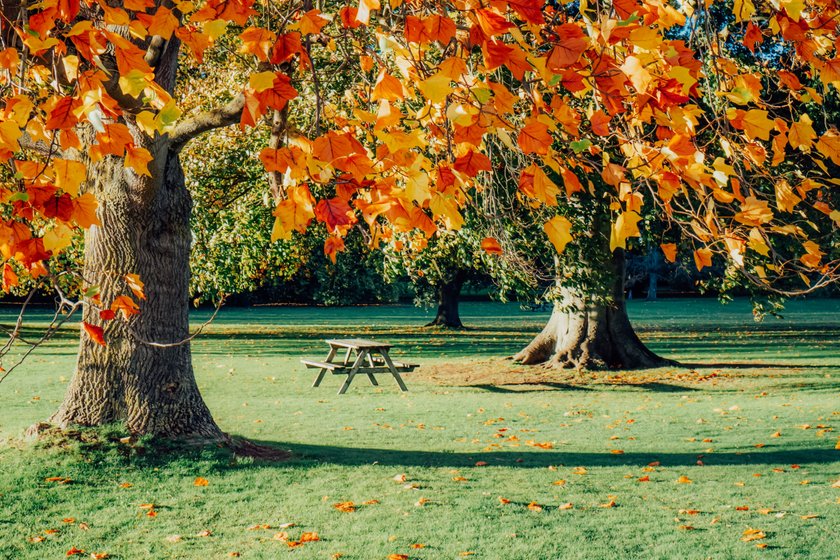
Photography teaches you to see differently. Autumn is about shades, transitions, and details. Fall leaf photography gives a reason to go outside, notice trees, reflections, or shadows, and become more attentive to the season. You don’t need to know everything at once. One shot or outing makes things clearer. Tools like Luminar Neo don’t do the work for you, but help express what you’ve already seen.





